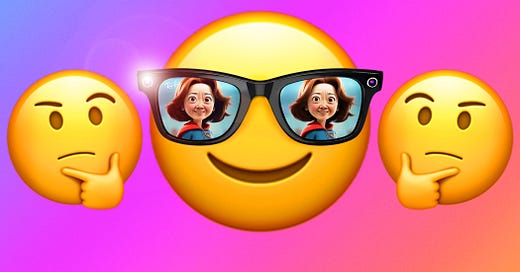Genmoji is Apple's gateway drug to generative AI
Apple Intelligence is shifting the Overton window one super mom at a time.
Apple’s WWDC keynote has long been used to set the stage for how it thinks about the future of its platform. This year, the story it told was all about AI. Not always referenced by name, but even when it was caveated by “machine learning” or described in more experiential terms, AI—as in, “Apple Intelligence,” of course, of course—was the driving force behind virtually every key feature. This was the event where Apple decided to present its pitch for AI, and already it’s changing how we talk about the technology, and in particular, how we talk about the more generative aspects of it.
Apple’s core image generation tools—Genmoji, Image Playground, and Image Wand—are all different slices of the same core concept. While I’m personally most interested in playing around with Image Wand, converting bad iPad sketches into more aesthetically-nuanced images, I think Genmoji might be the most impactful of this trio. With Genmoji, Apple is giving a very large audience an user-friendly way to experiment with AI image generation and to do so in an aesthetic mimicking Apple’s own emoji design language, which is to say, without the risk of copying another artist’s style. Its integration into iOS’s Messages app also makes it more likely that users will come to see it as an extension of their existing habits. (And, to be sure, it’s another way Apple can differentiate its iconic blue bubbles from Android now that it’s embracing RCS. But I digress.)
The more users play around with Genmoji, the more comfortable they get with generative AI, and by extension the more they’ll come to expect being able to visualize their ideas on demand via text input across all surfaces. It reminds me a lot of the Overton window, a comparison I’ve made ad nauseam to my MBH4H partner-in-crime James. The idea comes from political science and is used to describe the range of ideas that the mainstream population would consider acceptable, sensible, or popular. Over time, what is within this window shifts with public opinion. Something that might’ve been considered radical or unthinkable at one point might be rather sensible or even popular in another.
Generative AI, I’d argue, has long been on the fringe of this window as far as mainstream opinion is concerned, with their day-to-day utility vastly overshadowed by controversies and questions about the technology itself—How were these models trained, and on whose data? How will artists be compensated or otherwise protected? Will this bring about a surge in disinformation through deepfakes? (It doesn’t help, either, that the tech’s popularity is mostly defined by where it gets things wrong, most notably in the number of fingers and a glossy “sheen” that overlays many so-called “hyperrealistic” images.)
Those are all legitimate questions, and we should continue to be asking them—and to give Apple credit, they haven’t shied away from addressing at least some of these. But with Genmoji specifically, what Apple has done here is devise a generative tool with a narrow use-case (expressing ideas that aren’t available in the existing emoji library), using an output style that feels safe (by which I mean it’s copying Apple’s own emoji aesthetic, with its consent), and integrating it across one of the world’s most popular computing platforms (reducing the friction to incorporate this into everyone’s existing routines). It’s also very clearly meant for fleeting exchanges between friends and family—not something intended to displace commercial art, although it wouldn't surprise me at all if we started seeing more creative, liberal uses of generative emoji pop up in more places going forward.
If generative emoji become popular enough, in theory that means the Overton window of generative AI will shift toward more broad acceptance. And as users warm to this specific use-case, the more advanced generative models—Dall-E, Midjourney, Apple’s own Image Playground tools—will in turn start to feel less “icky,” especially as the technology improves. What was once seen as “Bad AI” will gradually shift into the range of “Good AI” by more and more people, and every AI tool that successfully makes that shift will make other AI implementations more palatable as a result.
It’s a shift we’ve seen before in technology. Think about how everyone reacted to Google Glass at first, with “glassholes” causing visceral reactions for their prominent camera. That was 2013, an era where smartphone cameras existed but the selfie stick was still a year or so out from becoming a popularized trend. In the intervening decade, we have all become so accustomed to being a background character in someone else’s photo that Meta’s recently-launched Ray-Ban smart glasses are talked about on the merits of the hardware itself, rather than larger societal implication. Where wearing Google Glass made you a pariah, Meta’s Ray-Bans “actually make the future look cool.”
Genmoji is the Ray-Ban-esque wrapper around controversial technology packaged for mass appeal.
It helps, of course, that the Ray-Bans look like actual sunglasses rather than Google Glass’s more unfamiliar, cyberpunk-lite hardware. And it’s also worth saying that, of course, those larger societal concerns around privacy and oversharing remain. But it’s clear that in 2024, the dopamine release of sharing most any candid moment has won out over those concerns and dramatically shifted selfies and amateur food photography from a disturbance to somewhere between “accepted nuisance” and “popular trend.” As Ellis Hamburger wrote all the way back in 2014, “We are all Glassholes now.”
As with a lot of moments in Apple’s history, while it’s not the first to commercialize a new technology, its savviness at telling an experience-first story and creating a more user-friendly implementation across a vast majority of its large iPhone audience makes this the single biggest expansion of users directly using generative AI. Genmoji is the Ray-Ban-esque wrapper around controversial technology packaged for mass appeal. It’s a turning point for consumers accepting the technology despite reservations or concerns.
But I haven’t addressed the biggest question of all, will users actually accept and use Genmoji? I suspect, as Marques Brownlee noted, that younger generations will embrace the new technology much faster and without as many reservations, much in the way every parent I know has a “my child poked our TV thinking it was touchscreen” story. At the same time, I think Ryan Broderick makes a very fair point that there’s a tendency to overstate Apple’s ability to shift tech trends on its word alone. (He’s also 100% right about their Image Playground examples looking hideous, to the point where I start to wonder if they did that on purpose to assuage any concerns about deepfakes.) But if it’s not Genmoji that moves the needle, then it will be Writing Tools. Or ChatGPT integration. Or freaking Math Notes—everyone loves Math Notes. Apple’s push into AI is so all-consuming that I think it’s safe to suggest that something will click, and when it does, Apple will proudly stand on stage and use that momentum to push the entire suite of Apple Intelligence tools. Because whether or not it substantially shifts sales, we’re now at a point where every major tech company has normalized AI. It’s unavoidable.
Questions about training models will inevitably fade in time—always relevant, just less at the forefront of the conversation. I think the misinformation concern is only beginning to take hold, as the technology will make discerning between fake Swagger Pope and real Swagger Pope even more difficult. But, if there’s a silver lining to all this, perhaps generative emoji is a way to help a broader audience understand what this technology even is, so that maybe we can have a better conversation around deepfakes with some shared knowledge on the topic. Yeah… that’s a bit too hopeful, I already realize. Anyway, back to the outro.
With WWDC, Apple has presented myriad use cases for AI across its entire portfolio. Come this fall, power users and parents alike will have system-integrated AI tools like never before, both in the Apple lineup as well as Windows with CoPilot. The question, then, shifts further from if users will accept the more controversial technology in their day-to-day lives to which generative tools will become generally accepted despite those controversies.







